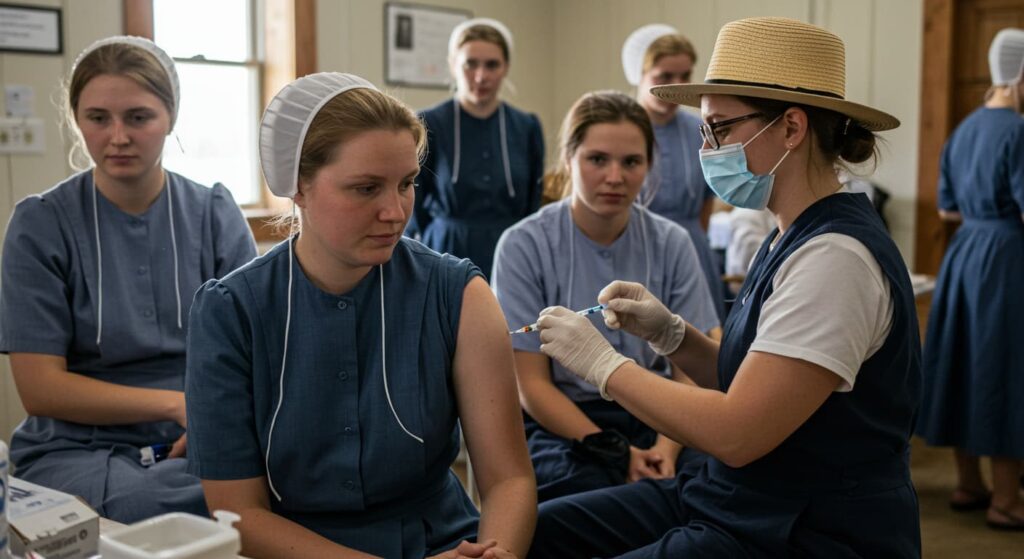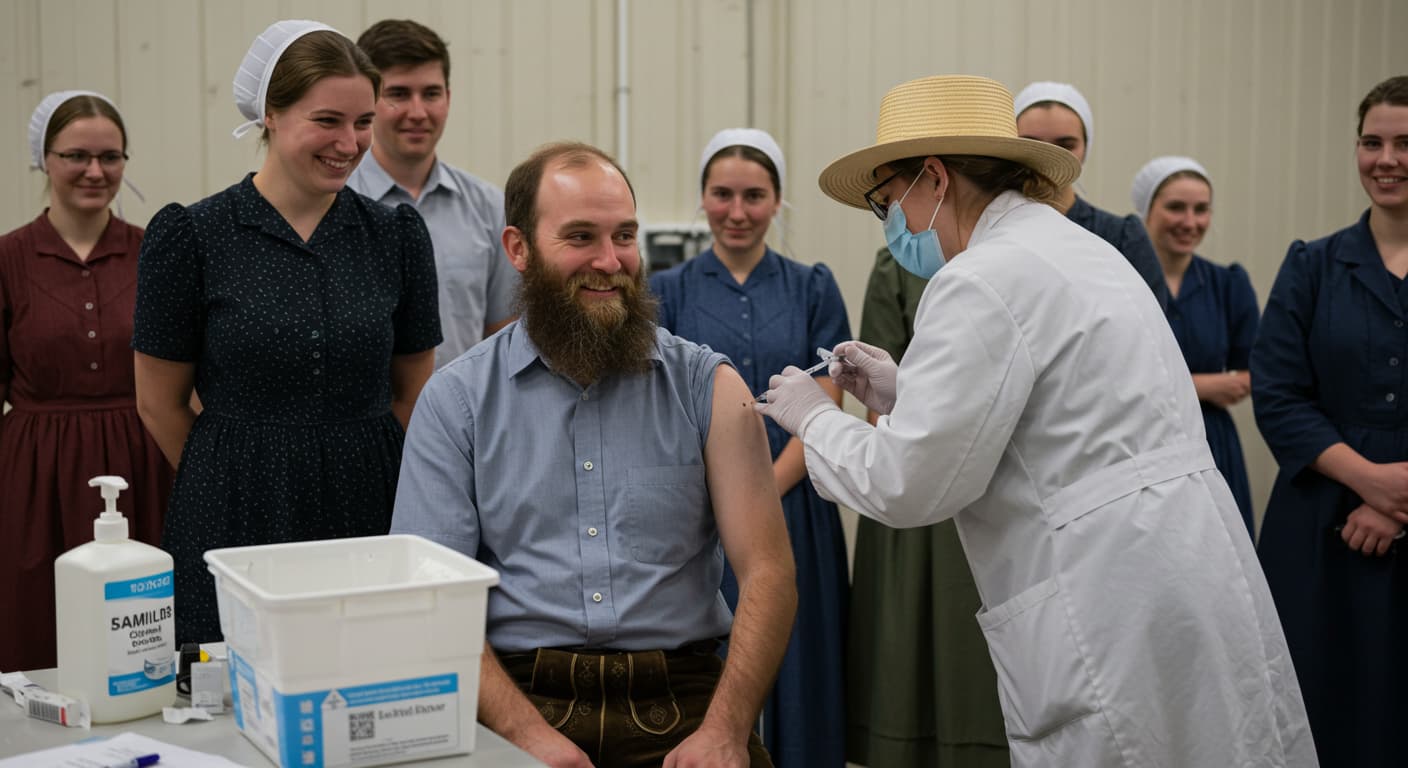Amish Don’t Get Vaccinated? That’s Not True! Vaccination Myths.
There’s a lot of misinformation out there claiming the Amish completely reject vaccination and, as a result, have almost no health issues like autism, cancer, or diabetes. Some even say their death rates from COVID-19 were far lower than the rest of the population.
However, these claims don’t hold up when you look at the facts.
Here’s a closer look at the reality of vaccination and health in Amish communities based on evidence and expert research I found available.
Do Amish People Avoid All Vaccines?
It’s a common myth that the Amish reject entirely vaccines, but the truth is more complex. While vaccination rates among the Amish are generally lower than in the broader population, they’re not entirely unvaccinated.
Many Amish families do vaccinate, but their decisions often depend on personal, family, community beliefs or preferences. A 2011 study in Pediatrics found that only 14% of Amish parents surveyed, didn’t vaccinate their children. While that’s higher than the national average, it means most Amish families choose some vaccination level.
Moreover, during health crises like the 2014 measles outbreak in Ohio, many Amish individuals decided to get vaccinated after unvaccinated missionaries brought the disease back from the Philippines (Gastañaduy et al., 2016).
Vaccination hesitancy in Amish communities often stems from cultural and religious factors, like a preference for simplicity and a mistrust of modern systems. Some view vaccinations as a form of insurance, which they traditionally avoid.
However, when healthcare workers approach the Amish with compassion and respect, many parents are open to vaccinating their children. This shows that hesitancy isn’t absolute but influenced by education and outreach.
What About the Claims of No Autism, Cancer, or Diabetes?
The claims that Amish children don’t experience conditions like autism, cancer, or diabetes are misleading and unsupported by research. These statements are often anecdotal (based on personal accounts rather than facts or research) and lack scientific backing.
For example, Steven Kirsch, an anti-vaccine activist, testified during a Pennsylvania state hearing that Amish children don’t suffer from these chronic conditions. However, he admitted later that he conducted no formal study and couldn’t provide evidence for his claims.
Research has consistently shown that while some health conditions may occur less frequently among the Amish, they are far from non-existent. For example:
- Autism: Studies, including one in the International Society for Autism Research (2010), found that autism does exist in Amish communities, though it might appear less often than in the general population. This may be due to cultural norms or underreporting since clinical assessments and diagnoses are less common in Amish communities.
- Diabetes: Amish children do experience diabetes, though rates may be lower compared to non-Amish children. This is mainly due to their active lifestyle and leaner body types, as noted in a 2013 study published in Diabetes Care.
- Cancer: Amish communities have documented cases of cancer, including breast cancer and juvenile leukemia. A study published in 1988 in Social Science and Medicine found both high and low rates of various cancers among the Amish, influenced by genetic and lifestyle factors.

What About COVID-19? Did Amish Communities Have Fewer Deaths?
Some claim the Amish had a COVID-19 death rate “90 times lower” than the rest of the U.S. because they weren’t vaccinated. This is false. Reliable studies show that Amish communities were not immune to COVID-19.
A study published in the Journal of Religion and Health (2023) found that excess death rates in Amish populations rose during the pandemic and even outpaced national trends as time went on.
Researchers from Penn State found that COVID-19 vaccination rates were indeed lower in Amish communities in 2022. They analyzed data from counties with significant Amish populations and discovered that vaccination rates were about 1.6% lower than in other areas.
While Amish communities were hesitant about COVID-19 vaccines, the claim that they were entirely unvaccinated is untrue. The Amish also conducted fewer COVID-19 tests, making gathering accurate data on infection and mortality rates harder.
Why Do Misinformation Campaigns Target the Amish?
The Amish often become a target for misinformation because they are seen as living “off the grid” and rejecting modern medicine.
However, experts like Dr. Katrine Wallace, an epidemiologist at the University of Illinois, stress that such claims are often based on cherry-picked anecdotes rather than facts. For example, Kirsch’s testimony about low Amish COVID-19 death rates was based on informal conversations and lacked credible evidence.
The Amish population is not a monolith when it comes to healthcare. Some communities are more conservative and reject vaccines, while others are open to them, especially in response to outbreaks or when guided by trusted healthcare providers.
A 2020 survey in Holmes County, Ohio, showed that vaccine acceptance is declining, with 59% of respondents choosing not to vaccinate their children. However, this still means over 40% do vaccinate to some extent.
Special needs children in the Amish community are more likely to receive vaccines than others, showing practice variability.
Improving vaccination rates among the Amish requires building trust and respecting their cultural values. Public health officials must engage with Amish leaders and families to address vaccine fears and misinformation. Studies have shown that physician advocacy and collaboration with church leadership can significantly promote vaccine acceptance.
Vaccination in Amish Communities is a Myth
The idea that the Amish entirely reject vaccines is a myth. While vaccination rates are lower in Amish populations, most communities are not altogether unvaccinated.
Health conditions like autism, diabetes, and cancer do exist among the Amish, though at varying rates influenced by lifestyle, genetics, and cultural practices—not solely vaccination status.
Understanding the Amish perspective on vaccination requires nuance, respect, and evidence-based outreach. As Amish communities grow and spread to new regions, continuing to study and engage with them will be critical for improving public health outcomes.
Sources:
- Gastañaduy et al., 2016
- Pediatrics (2011)
- International Society for Autism Research (2010)
- Diabetes Care (2013)
- Social Science and Medicine (1988)
- Journal of Religion and Health (2023)
- Penn State Study on Amish COVID-19 Vaccination Rates (2022)

